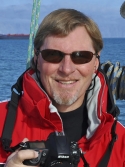OldCrow-Yukon-Tombstone.jpg
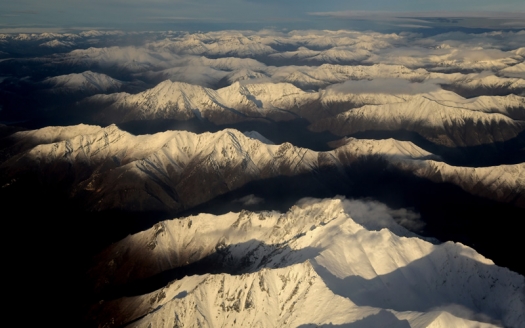
Photo ©2018 David Thoreson; used with permission.
The Tombstone Mountains offer a formidable gateway to the northern Gwich'in community of Old Crow, Yukon. The name stirred thoughts connected to the plight of the ingenious communities struggling with climate change, food insecurity and cultural survival.
“Izhik Gwats’an Gwandaii Goodlit”
In the Gwich’in language, that means “the sacred place where life begins.” The term refers to the coastal plain of the Arctic National Wildlife Refuge where some 200,000 caribou birth their young after making the longest land-based mammal migration on the planet.
I visited the remote region along with other photographers and filmmakers to help create awareness of the Arctic Refuge and highlight the likely threats of planned fossil-fuel development. On the Canadian side of the U.S. Arctic Refuge sits the small village of Old Crow, Yukon, nestled along the shores of the Porcupine River. The Vuntut Gwich’in people depend upon the Porcupine Caribou which migrate this well-worn path to, and from, the coastal plain. They have voiced grave concerns over pending oil development.
The flight north from Whitehorse, Yukon, revealed fog-draped valleys and the fading colors of late autumn. I leaned over and asked Mark Kelly, a photographer from Whitehorse about the snow-capped mountain range below. “Those are the Tombstone Mountains,” replied Kelly. I gazed back out the plane window at the pristine white peaks and my thoughts began to swirl.
The unfortunately named Tombstone Mountains serve as a rugged gateway to the remote village of Old Crow, where the Vuntut Gwich’in people live. They have inhabited this region for at least 25,000 years, primarily because of the predictable migration of caribou. The Vuntut Gwich’in harvest the animals sustainably, using every part for food, clothing and tools. But their culture is under threat of disruption on two fronts: rapid climate change and pending fossil fuel extraction. These are the defining issues that bring me and other documentarians to Old Crow, ground zero of the fight over public land use and how policy changes affect indigenous culture, and nature itself.
Yukon-based photographer Peter Mather, working with the International League of Conservation Photographers (ILCP), helped assemble multiple teams of photographers and filmmakers with 11 different missions to document life in and around the U.S. Arctic National Wildlife Refuge.
At 19 million acres, the refuge is one of the last pristine wilderness areas of the far north. Plans to develop the Arctic Refuge have fueled one of the greatest debates the modern environmental movement has ever witnessed. Can protections be put back in place in time?
OldCrow-Yukon-StephenFrost.jpg
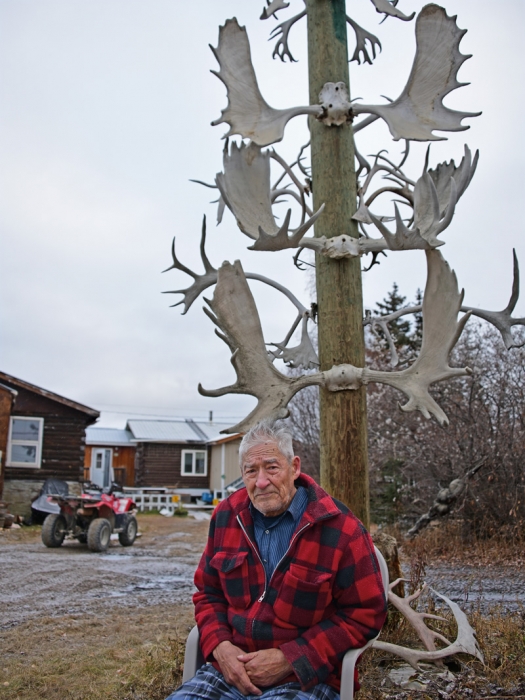
Photo ©2018 David Thoreson; used with permission.
Stephen Frost is a Gwich’in elder and cultural ambassador living in Old Crow, Yukon. Frost worries about climate change and is very concerned with protecting the Arctic Refuge and the Porcupine Caribou herd for future generations.
After arriving in Old Crow, situated just on the Canadian side of the U.S. Arctic Refuge, Kelly and I were hoping to embed with local Gwich’in hunters for the autumn caribou hunt. An immediate problem appeared, however: The caribou were nowhere to be found. Village elder and longtime hunter Stephen Frost spoke measuredly about the issue: “I’m 86 now. It doesn’t make me better, it just means that I’ve seen all the changes. When I was a kid at Bluefish, every fall there were thousands of caribou coming, crossing the river, getting in and going up the other side. You don’t see that no more.”
A new Arctic Report Card documents the rapid decline of caribou (or reindeer) populations worldwide. Fifty-six percent of all caribou, some 2.6 million animals, have died off in the past 20 years. Climate change in the Arctic has become a “threat multiplier.” Extreme seasonal changes have affected everything from bugs and parasites to winter snow cover. New freeze/thaw cycles combined with freezing rain are changing soft snow into icy barriers, making it impossible for caribou to forage.
The herd that migrates within the Arctic Refuge is currently estimated at 200,000 head. With the added threat of oil drilling beginning as soon as 2020, the caribou will be even more endangered. The seismic testing scheduled to begin this winter has been delayed indefinitely because of tremendous public outcry.
OldCrow-Yukon-PaulHunts.jpg
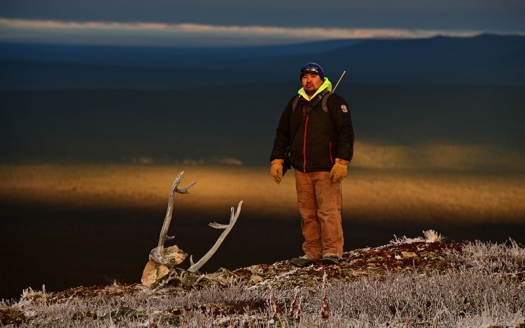
Photo ©2018 David Thoreson; used with permission.
Paul Josie is an avid hunter, fisherman and outdoorsman with a dream to run his own eco-travel company in the Old Crow, Yukon, region. Josie is also a young community leader serving as a councillor for the Vuntut Gwich’in First Nation.
Young Gwich’in community leader Paul Josie was our liaison in town. As with all residents of Old Crow, Josie wears many hats. Along with serving as a councilor for the Vuntut Gwich'in First Nation, he is a well-known and successful hunter, fisherman and outdoorsman.
“It doesn’t matter how old you are,” said Josie with a huge smile. “I still hear some elders talking about the adrenaline rush from seeing the caribou, and knowing that you can provide for your family, for your people. It’s a natural high that fills you with joy and excitement.”
OldCrow-Yukon-Paul-Vicky.jpg
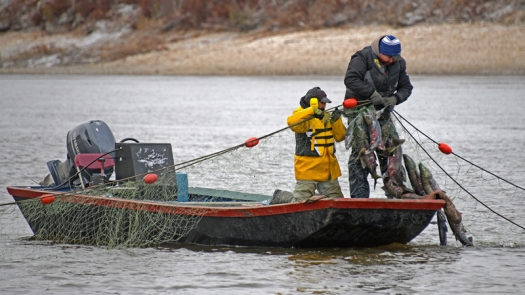
Photo ©2018 David Thoreson; used with permission.
Paul Josie (right) and his mother, Vicky, use a gillnet to fish for Chum Salmon on the Porcupine River near Old Crow, Yukon. Chum are often called "dog" salmon as they are often fed to sled dogs.
While caribou are the lifeblood of the Gwich’in people, the Porcupine River is the “highway” for a village accessible only by plane. With no caribou to hunt, many people had turned to preparations for winter, including gathering wood and fishing. Paul Josie and his mother, Vicky, worked the gill nets for a few days, catching dozens of chum salmon for their sled dogs. There are always new challenges, and constant chores, when you rely on from the natural world for your sustenance.
OldCrow-Yukon-DanaTizyaTramm.jpg

Photo ©2018 David Thoreson; used with permission.
Dana Tizya-Tramm is the youngest person to ever be elected chief of the Vuntut Gwitch’in. Tizya-Tramm represents a new generation of leaders concerned with climate change, oil development and cultural survival.
Old Crow resident Dana Tizya-Tramm is the youngest person to be elected chief of the Vuntut Gwich'in. He speculated about an uncertain future: “This is not just a Gwich’in issue; it’s an issue for the world. If we can’t come together over this, and if climate change can’t bring us together to fulfill the dreams of our ancestors, then we have no business being on this planet anymore.”
Paul Josie has heard of some caribou sightings up the Porcupine River. The weather is turning cold quickly, and many in the community are thinking this will be the last trip of the season. We loaded gear and traveled upriver in Josie’s small, open fishing boat. Mark and I soon felt like frozen human windshields in the icy air.
We spotted a couple of bald eagles and grizzly bears as we passed by multigenerational hunting, fishing and trapping camps. Families were closing up cabins and folding up wall tents ahead of winter’s fast approach. We saw no caribou but one boat held a fresh kill and Josie perked up with excitement.
A coffee break and a visit with Mary Jane Moses at her family’s river camp was most welcome. Moses is the Heritage Coordinator for the Vuntut Gwich'in First Nation. The soft-spoken Moses stated: “If ever there was to be development in the calving grounds, our communities would be affected in a really bad way. The caribou is our food; it’s our main source of food. If we don’t have the caribou, what other options do we really have?”
After many windblown hours, we arrived at Josie’s Driftwood Camp. There were still no caribou so we settled in and listened as he told stories about hunting, fishing and trapping in the area. The sunset’s mellow glow seemed to last forever. It was a special moment, in a magical place, surrounded by unparalleled beauty.
The boat ride back to Old Crow was uneventful but for the rare sighting of a Canada lynx hunting ducks along the shore. The Porcupine River was freezing up. It was time to pack our gear and head back to Whitehorse.
Mark and I made one last visit to Stephen Frost. His health was failing, and he was in tremendous pain. I sat with him while Mark made coffee. We shared small talk. To cheer Stephen up, Mark told him about a local man who said the caribou would start the fall rut on Crow Mountain around mid-October. Stephen looked at Mark and said, “Did you tell him he’s full of shit? What the heck does he know about what the caribou think?”
We laughed heartily. For a moment, I had a vision of caribou running freely over the land as in the old days. Stephen was correct; despite all of our human history and development, we still don’t know what the caribou think.
“The Arctic Wildlife Refuge – it’s been there a long time, probably before me,” quipped Frost. “The caribou go to the same place every year, so if the refuge is disturbed by oil companies, or something, the caribou might leave, but where are they going to go?”
Where the caribou go and what happens to the Gwich’in culture are dependent upon decisions made far away from the remote Arctic. While these policy battles settle, there is a last stand being mounted, in a last place. A red line has formed, wilderness versus oil. At stake, the sacred place where life begins.

